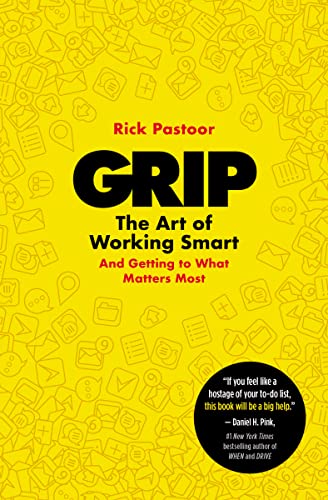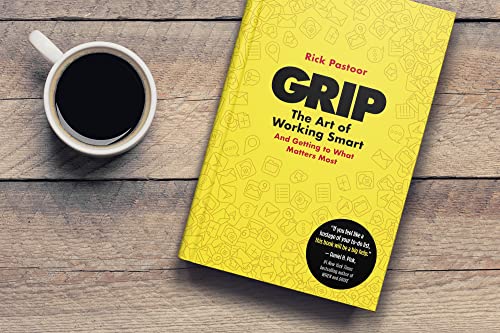




Grip: The Art of Working Smart (and Getting to What Matters Most)
W**R
Extremely applicable and helpful book for organizing your life and priorities.
This book does a great job giving you a clear-cut system for organizing and optimizing your schedule to get after what's most important to you.
J**R
Practical Productivity Methodology
Grip contains a comprehensive set of productivity methodologies that span the minutia of daily tasks, long-term goals, and even the philosophies of life itself. The methods are intuitive and practical. No special software is needed, and I suspect that most people are doing some things that Rick Pastoor suggests in some form or another. The advantage here is that Rick has fine-tuned these methods and woven them together synergistically. By slowly implementing these methods (some required significant changes to my working habits!), I have seen a boost in my productivity.The first part covers the nitty-gritty of planning your daily activities and dealing with the continuous inflow of new action items. It is where I suspect most will find the most gains. Underlying it is Rick Pastoor's "3-stage rocket," which is first calendar, second to-do list, and third email. This rocket helps keep you on track and aware of what you should be working on at any moment. It can be summarized as follows:1) Calendar: Schedule your week in advance, filling in every half-hour block2) To-do list: What is not on your calendar (because you can do it in less than half an hour), put in your to-do list (immediately to off-load it from your brain) and work on it when you have nothing else scheduled3) Email: Only look at emails in three scheduled half-hour chunks daily. Address things that you can do under two minutes immediately, and put the rest on your calendar or to-do list.It sounds simple, but doing everything together has had a massive impact on my productivity. I was doing many of these things in some form, but I was undisciplined and lacked a larger perspective. Rick Pastoor is open about drawing ideas from different sources (like David Allen) but weaves these ideas together in a way that is fresh and empowering. At a minimum, all you need is some discipline, a calendar, and a place to write things down.The second part covers longer-term planning and goals. It also contains practical advice, and I particularly liked the section on goals. I have often heard about "S.M.A.R.T." goals but find that methodology too complicated. Rick, too, recognizes this and suggests a method that is easier. It exemplifies how he stresses the real-life practicality of his solutions throughout the book (especially in the first two sections). His ideas do not just sound good, but they can also be implemented and maintained without significant effort.The third part covers approaches to life itself and is much more philosophical than practical. The main topics are learning how to listen and solve difficult problems. I found the least benefit from this section, but your mileage may vary.Overall, this is an excellent book, and implementing just a few of his ideas will provide immediate gains. His ideas are relatively simple, intuitive, and, in some ways, self-sustaining. Each section contains a cheat sheet at the end for quick reference. I find myself referencing them often. If you are looking for a way to boost productivity, I highly recommend Rick Pastoor's Grip.
O**D
Good Review of Principles
Lots of good information, most of which is easily found in a number of other books. If you're already read The 7 Habits of Highly Effective People, The One Minute Manager, The Effective Executive, and Good To Great, this books doesn't add much. Good review? Yes. In addition, there were two things in this book that were new to me, and therefore really valuable. And one thing I really disagree with. First, the new things. One is a quote from Peter Drucker. I've read him before, all of his books, including the collections, but I either missed this quote before or this time it just really said "Eureaka!" to me. Here's the quote: "Develop your priorities and don't have more than two. I don't know anyone who can do three things at the same time and do them well. Do one task at a time or two tasks at a time. That's it." Then Pastoor adds a great thought: "Because the thing is, if you set yourself five priorities, you really haven't prioritized at all." That's two great quotes on the same topic. Very simple yet profound.The second new thing I read in this book comes in Chapter 10, an outline of four key ways the brain works. It's really powerful. To me, just learning these four things and applying them to everyday leadership, including self leadership, is worth the price of the book. Good stuff.The item I disagreed with was the assertion that your calendering and to-do list plans should be electronic, not on paper. I have tried it both ways, and worked with a lot of people who have tried it both ways, and in my experience most people do better on hard-copy paper. That's counter-intuitive in our modern world, but I've seen it work this way over and over. It is true of the older generations, not surprisingly, but it is also true of Millennials and Gen Z. Not all of them, of course. Some people really do better with electronic planning--but a majority seem to do better with paper. Surprising, but real. Try both and see what works best for you and others. It may differ by career or other factors, I don't know.All in all I wish the book had more new things, especially since the 4 ways the brain work was so impactful and useful. As I said, a good review of a lot of leadership and management principles. I hope the author follows up with another book that is less based on summaries from other leadership books and more focused on his original thinking. He's good at it. I hope he'll share more. Good read.
I**D
Good book for learning to be more efficient with your time
This review is for the book Grip: The Art of Working Smart. The book is meant to help you organize your life and everything in it in a way that helps you tackle your to-do list without letting it grow out of control. The idea here is that after reading this you will understand how to better prioritize things to work through your issues in a smart way rather than let them pile up uncontrolled.This helps break your life up into weekly, yearly, and future goals so you can focus on what matters now and knock that stuff out while also keeping tabs on the direction you want to head in. The beginning of the book breaks down productivity and how to handle all of the digital things that are thrown at us daily. A lot of the advice in here are things you may have heard before as it is quite a bit of common sense. However as they say, common sense is not so common.I think the one place this book falls a bit short is in the perspective it is speaking from. The writer is speaking as the CEO of a company and how they see things from their perch there. This is not bad necessarily but it does make some of the advice and bits of info in here less relatable than they could have been.Overall the book was easy to read, packed with tips for working more effectively, and just a solid read.
A**E
Filled with useful tips for improving productivity and more
I'm reviewing this book from the perspective of someone who has read quite a few books on productivity but struggles to apply the concepts presented. Rick Pastoor's book goes over some of the same concepts put forth in most books on boosting productivity, but also provides tips to implementing those changes. While there are a lot of good ideas and tips contained within the pages, many of them aren't new. If you have no experience with methods for improving productivity and are looking to boost yours, this will be refreshing and entirely new. If you've read all of the other books, this might not be a game changer for you, but you'll likely still glean some insights. The book is well written and an easy read.Part 1 focuses on optimizing your time. Part 2 focuses on optimizing your goals. Part 3 focuses on optimizing yourself - all three components together will lead to being more efficient and effective in the workplace and at home.Even though the book is an easy read, implementation is not easy. It will take most people a solid year to be able to fully incorporate the tips in this book into their lives, even though the book can be read over a day or two.